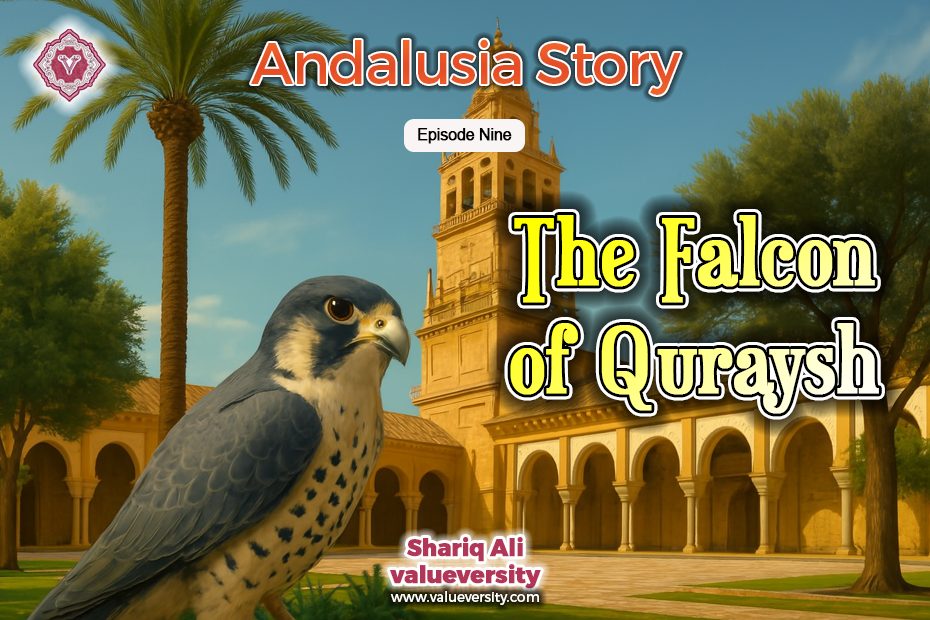The Falcon of Quraysh ،Andalusia Chronicles ، Episode 9
✍️ Shariq Ali
Valueversity
At 2 p.m., we stood beside the outer wall of the Great Mosque of Córdoba. As our group gathered, we entered through the main gate. Leaving behind the bustling street filled with energetic Spanish youth, entering the silent courtyard of the mosque brought about an inner shift،
as if a scene filled with noise had suddenly transformed into one of silence.
Just beyond the walled gate, a vast garden unfolded before our eyes. Bathed in sunlight, the shadows of palm and olive trees fell upon marble walkways leading to the mosque’s main structure. Walking along these paths, we reached the inner wall of the mosque. Pedro was busy for a few minutes arranging our group’s entry into the main building. As we looked around the open courtyard and toward the wall, a tall and striking minaret caught our attention in one corner.
Looking closely, it was clear this was not just a minaret، it was a historical manuscript carved in stone, holding within it stories spanning centuries. The foundations displayed Roman architectural influence: straight lines, wide stone blocks, and a distinct Roman sense of solidity. The middle section revealed features from the Islamic era، arches, balconies, and intricate traditional Islamic motifs.
At the very top, bells from the Christian era seemed to announce a new chapter in history. This minaret stood like a silent document of time, its every layer narrating the story of a different age and civilization.
As I looked at the minaret, the name of Abdul Rahman Al Dakhil emerged in my thoughts. The young Umayyad prince who escaped alive from Damascus during the fall of the Umayyad Caliphate. Fleeing from the brutal Abbasids, he crossed the Euphrates. He had witnessed the massacre of his brothers and family with his own eyes, and then spent years wandering homeless and alone, across the deserts of Africa, Egypt, Palestine, and finally the land of Morocco.
After four long years of struggle, he eventually reached Andalusia. He understood the internal rivalries and politics of the Arab tribes there. With wisdom and diplomacy, he united them and, in 755 AD, established his authority in Córdoba. It was this very prince who laid the foundation of a new kingdom in al-Andalus. He made Córdoba his capital and began the construction of the Great Mosque of Córdoba.
The mosque was his passion. He made it not merely a place of worship, but a symbol of Islamic civilization. He would arrive at the mosque through a secret passage, lead the Fajr prayer, and return silently. Despite the dangers, he stayed close to his people, never imprisoning himself within a palace.
Construction of the mosque began in 784 AD, row upon row of columns inspired by palm trees, marble arches, and walls adorned with beautifully inscribed Qur’anic verses, all reflecting his refined aesthetic sense and deep spiritual connection.
Historians write that when he would sit alone in the mihrab (prayer niche), memories of Damascus would return to him: the cries of his murdered brothers, the riverside where he had escaped, and the exhaustion of deserts. This mosque was not just a construction project for him, it was a sanctuary for his soul.
We were still waiting to enter the main hall of the mosque. It felt as if the stillness of the courtyard, the shadows cast by the mosque’s walls, and the towering minaret were all saluting the greatness of Abdul Rahman I, a man who, despite being wounded and exiled, rose as a victorious leader and was remembered in history by the title:
“The Falcon of Quraysh” (Ṣaqr al-Quraysh)
This noble title was bestowed in recognition of his political acumen, unwavering resolve, and exceptional leadership. It is said that even his enemy, the Abbasid Caliph Al-Mansur, once praised him, saying:
“Had this young man come to me, I would have made him the light of my eyes. Truly, he is the Falcon of Quraysh.”
In Arabic poetry and literature, the falcon symbolizes resilience, high ambition, and a sharp, opportunistic hunter, qualities that were undeniably present in Abdul Rahman. After the fall of the Umayyads, he arrived in Andalusia alone and, through his intellect, insight, and strategic leadership, established a powerful Umayyad kingdom in Córdoba, one that lasted for the next three hundred years.
…To be continued
